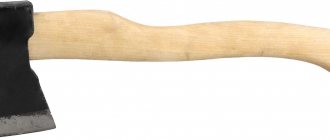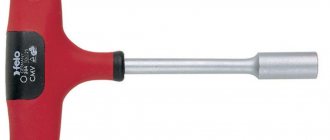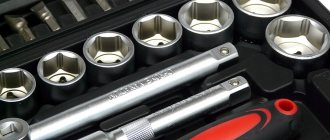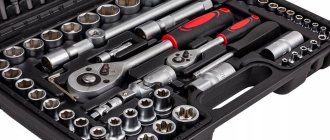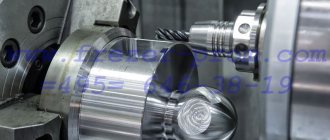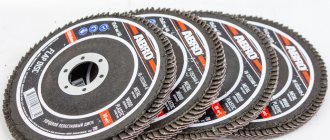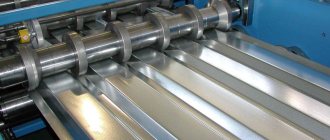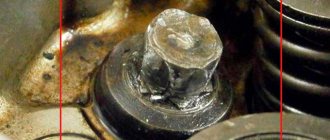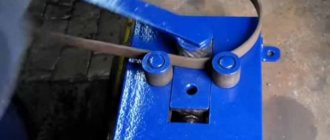Fasteners are the main element in cars, metal and wooden structures. These include: bolts, screws and nuts. Thanks to fasteners, structural integrity and precise functioning of components, machine wheels, engine mounts and lifting mechanisms are achieved.
When servicing components and assemblies, you have to unscrew or tighten fasteners, and you can’t do this without a special tool. A wrench or ratchet will do the job. The second one greatly simplifies the work today.
Advantages of using a ratchet wrench
Using this tool provides a number of advantages, including:
- To tighten or unscrew the fastener, you will need to turn the ratchet with a little force. This allows you to work with large bolted connections (where maximum effort is needed);
- Replacing a wrench with a ratchet increases productivity;
- The tool in question copes better with the task when working with bolted connections in hard-to-reach places. Nothing can be said about the classic analogues. The ratchets cope with the task even when it is not possible to throw the wrench.
Special heads
They are special tools for working with individual components or assemblies of cars. They are presented in multiple versions and are used exclusively for certain jobs with a specific model or brand of machine. Such as repairing generators, unscrewing wheel bearings, replacing shock absorbers, replacing chains or timing belts, etc. They are mainly used at car service stations, less often - by car enthusiasts with experience in locksmith work.
Among the special ones, perhaps, it is worth highlighting the heads for dismantling/installing oxygen sensors (lamda probe), which are also applicable for injectors and oil pressure sensors. This is perhaps the most popular special tool among socket heads due to their versatility. A small set suitable for work on almost all modern cars. Used with hand tools and mainly at service stations or by people with experience in car repairs. In addition to sets, they are also sold individually.
Ratchet wrench device
Steel is used for manufacturing:
- chrome vanadium;
- stainless;
- chrome molybdenum;
which gives the tool mechanical strength and resistance to corrosion.
The design of the wrench involves a handle and a head with a ratcheting mechanism, thanks to which the fasteners are unscrewed without tearing off the tool. The rotating mechanism is located in a closed mouth. The mechanism rotates in one direction or in two. In the first case it is a one-way key, and in the second it is a two-way key.
Socket set for ratchet wrench
The direction of rotation is changed by a switch, which can be a disk or a flag. The presence of a gear with teeth (24-72) ensures rotation. The greater the number of teeth, the smoother the operation of the tool.
Recommendations for selection
Total number of items. First of all, consumers pay attention to the total number of items in the set. And there can be more than 200 units. However, as practice shows, you should not chase quantity. Some of the tools will most likely never be used for work. Therefore, it is worth determining in advance the scope of the keys and making a list of the most important elements for yourself.
Features of the package
. The case contains not only keys, but also equipment and accessories.
- Tools are considered to be socket wrenches, socket wrenches, wrenches, adjustable wrenches, pliers, pliers, screwdrivers, hammer, ratchet.
- Useful accessories can include short, long and flexible extensions, magnetic probes, a universal joint for heads, tape measures, indicator screwdrivers, and a magnetic probe.
- The role of equipment is played by bits, heads with inserts, and socket heads.
Materials
. Manufacturers use a number of materials when making key sets. The reliability and durability of the kit depends on their quality.
- Chrome vanadium steel demonstrates the optimal combination of high strength and low weight. Heads or spanners are made from it. The strengths of the material include corrosion resistance, beautiful appearance and ease of maintenance.
- Bits and sockets are made from S2 steel. It has high hardness, but after use the tool should be wiped to prevent rusting.
- A ratchet is a useful item that speeds up the process of unscrewing and tightening hardware. Since the load is carried on the mechanism, steel structures have maximum durability. Before work, it would be a good idea to make sure there is lubricant inside the mechanism.
- To store a large number of keys, equipment and accessories, you cannot do without a spacious case. All of them are made of durable plastic. When purchasing, special attention should be paid to the reliability of fixing each item in the grooves and niches.
Our review includes the 7 best ratchet sets. All of them are sold in domestic stores. When distributing positions, the editors of the expertology magazine relied on the opinion of experts, taking into account reviews of Russian consumers.
Types of ratchet wrench
Two tool options have been developed for working with fasteners:
- Cap . Outwardly similar to a classic box wrench. Equipped with two working parts, different in size. This is convenient if during work you need to change the key to a larger one without interrupting the process. The ring ratchet has found application in car repair and maintenance. The presence of thin walls of the head of the wrench (for example, Jonnesway W681415) allows the tool to get into hard-to-reach places and transport nodes.
- Socket tool . This is the most popular type of wrench, with a square slot for heads for fasteners.
In addition, ratchets are divided into 4 types, taking into account the size of the nozzles:
- 1⁄4
— the size of the nozzles is 4-14 mm. The tool is used when working with small-sized threaded connections located in hard-to-reach places; - 3⁄8
– head size 8-22 mm. These are not particularly popular, but in vain. Craftsmen recommend confidently buying such tools for work at home and for repairing a passenger car; - 1⁄2
— size 8-22 mm. This is a popular type of key. But you need to work with it carefully, especially when tightening 8-10 mm nuts. If you do not calculate the force, there is a risk of breaking the thread or head of the fastener; - 3⁄4
— size 19-46 mm. This is the largest tool that has become widespread in the manufacture and repair of heavy equipment and large structures.
All about socket heads: types, profiles, head sizes in inches and mm
Socket heads: what is important to know?
Socket heads, they are also socket wrenches, they are also socket wrenches. All heads can be divided into 2 large groups.
The first group is heads with a through hole (under the knob). The size range starts from 17mm.
The main advantage of these wrench heads is that to work with them
you do not need a special wrench, which for large heads costs much more than the head itself.
You can use a pry bar or any other wrench of a suitable diameter. Among the disadvantages, we note the inability to work in confined spaces and with recessed fasteners. It is not possible to use an extension cord for work. The second group is heads with a connecting square under the knob. The size range starts from 4mm.
It is worth telling more about this group. For convenience, we will divide the group according to certain parameters. The first parameter is the size of the connecting square. The connecting square or landing square is a tetrahedral hole on the back of the head. The size of a square is measured in units that are unusual for us - inches. Inch from Dutch duim - thumb). An inch is indicated by a double stroke ” and is equal to 25.4 mm. Interestingly, the OIML (International Organization of Legal Metrology) considers the inch to be a unit of measurement that should be phased out as soon as possible and that should not be introduced where it is not currently used. In the Russian Federation, the inch is approved for use as a non-systemic unit without a time limit with the scope of application “industry”. 5 most popular standard sizes of connecting (landing) squares. 1″, 3/4″, 1/2″, 3/8″, 1/4″. Frequently asked question: how much is it in millimeters? Answer:
- 1 inch = 25.4 mm,
- 3/4 inch = 19.05 mm,
- 1/2 inch = 12.7 mm,
- 3/8 inch = 9.53 mm,
- 1/4 inch = 6.35 mm.
The larger the connecting square, the more powerful the head. The wall is thicker, the maximum load is higher. For example, a 27mm head. can be with connecting squares: 1/2″, 3/4″, 1″. Naturally, the wall thickness and safety margin will increase when moving to a larger connecting square.
The size range of heads is also tied to the size of the connecting square.
- Square 1/4″ - heads from 4mm to 14mm.
- Square 3/8″ - heads from 6mm to 24mm.
- Square 1/2″ - heads from 8mm to 36mm.
- Square 3/4″ - heads from 17mm to 70mm.
- Square 1″ - heads from 36mm to 80mm.
The second parameter is applicability. 1. IMPACT heads for working with pneumatic and electric tools. The heads are designed to withstand shock loads. Made from high quality steel with added molybdenum (Mo) for toughness. Typically oxidized, black.
Unlike standard heads, they have a thicker wall, although there are also thin-walled impact heads, for example, for working with cast discs.
2. Heads are STANDARD. Designed for manual work with a crank.
Protected from corrosion by galvanizing or chrome plating. All heads on our website: https://vk.cc/5OlLOI The third parameter is the head profile. 1. Twelve-sided profile. Heads with this profile allow you to work with both hexagonal and twelve-sided fasteners.
2. Standard hexagonal profile. The most common, most tool sets are equipped with heads with exactly this profile.
3. Hexagonal profile SuperLock, Surface, Multidrive. The profile is similar to a hexagonal one, but the contact area with the fasteners is increased. Heads with this profile are shown for working with licked fasteners; inch fasteners can also be unscrewed. We talked about this profile in detail here
4. TORX profile or E-standard. These heads are designed for unscrewing fasteners with a TORX profile (6-point star)
The fourth parameter is the height of the heads. The heads are high.
Standard height heads.
All new items
How to use a ratchet wrench
To ensure that the tool lasts as long as possible, follow the safety recommendations:
- It is prohibited to use a lever to create additional force;
- It is prohibited to use auxiliary spacers between the edges of the fastener and the key. This option is possible when the required tool size is not available;
- At the end of the work, wipe the key with a rag;
- It is allowed to work only with working tools. When the ratchet tool is broken due to wear or increased permissible pressure, then such a wrench cannot be used.
